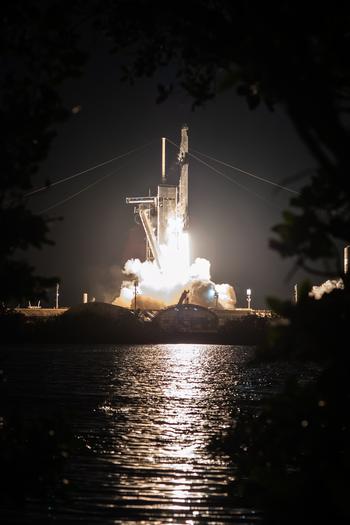
Navy researchers for the first time demonstrate laser power beaming technology at the Naval Surface Warfare Center in Bethesda, Md., on May 23, 2019. After a SpaceX launch this week, the Navy is now ready to spend a year testing the same laser-based technique at the International Space Station to see how wireless power transfers work in space. (Leonard Pieton/U.S. Naval Research Laboratory)
WASHINGTON — An experimental military project that will test laser beaming technology has arrived at the International Space Station and will spend a year in orbit, Navy officials said.
The Navy sent the project into space on a SpaceX Dragon cargo vehicle that launched late Tuesday at Cape Canaveral in Florida, officials said. The vehicle docked at the space station on Thursday.
The SpaceX flight carried several other pieces of equipment to the space outpost and the laser package — part of the Pentagon’s Space Test Program — will carry out various experiments to test power beaming, a technology that transfers energy instantaneously through electromagnetic waves. It’s also known as wireless power transfer.
Power beaming has already proven to be safe and feasible on Earth, the Navy said. The new project — officially known as the Space Wireless Energy Laser Link, or SWELL — will test its effectiveness in low Earth orbit in zero gravity.
Power can be transferred on electromagnetic waves through multiple techniques, such as lasers and microwaves. If it works in low Earth orbit, naval officials said the technology could offer significant potential for space defense applications.
“With this modest experiment, we will identify key focus areas for developing links of greater power and longer distance for space,” said Paul Jaffe, electronics engineer and SWELL principal investigator. “By employing laser transmitters … power beaming links will be established that will pave the way for rapid, resilient and flexible energy delivery systems.”
The Naval Research Laboratory demonstrated laser power beaming on the Earth during an event at the Naval Surface Warfare Center near Washington in 2019. The laser, which transferred 400 watts of power more than 1,000 feet between two 13-foot-high towers, is invisible to the naked eye.
“By eliminating the need for moving fuel or batteries, or for stringing wires, SWELL could be a compelling option for the utilization of lunar resources and development on the moon,” the Naval Research Laboratory said.

A SpaceX Falcon 9 rocket carrying a Navy experiment on a resupply mission to the International Space Station lifts off Tuesday, March 14, 2023, from NASA’s Kennedy Space Center in Florida. The Navy’s experimental project, known as SWELL, will spend a year in orbit to learn how laser-based power beaming technology works in space. (NASA)
Officials said the SWELL project will collect and study data that the Navy expects will shed light on how power transfer equipment behaves in space. The project is also expected to uncover any issues that could create problems with the technology later.
The Navy isn’t the only service experimenting with wireless power beaming in space. Last year, the Air Force said its researchers were testing beaming technology with energy collected from the sun and transmitted back to Earth for military use on the ground.
“There is a high possibility that this technology could be a highly valued asset in the commercial sector as well,” the Air Force Research Laboratory said at the time. “Much like the Global Positioning System, which started out as a military asset and transitioned to a technology now used by people everywhere, this solar power beaming system could transition to broader usage, providing solar energy regardless of weather, time of day, or latitude.”
“Space solar power beaming has the potential to provide energy anywhere on Earth at any time,” said Tara Theret, director of the solar beaming program at Northrop Grumman, which partnered with the Air Force on the project. “This technology could make power available to remote locations that need medical and communications equipment.”
The Navy said its newly launched SWELL program also might lead to discoveries that will pave the way for power delivery from space to the Earth.
“Power beaming might also be used for distributing power for and around Earth, including from satellites that collect solar energy in space,” Jaffe said. “SWELL is the next step into this new frontier.”